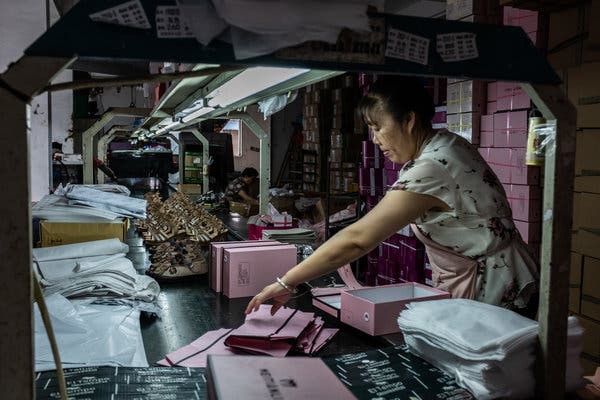Will Trump's 30% Tariffs On Chinese Goods Last Until 2025?

Table of Contents
The Initial Rationale Behind the 30% Tariffs
The Trump administration's imposition of 30% tariffs (and other tariffs ranging from 10% to 25%) on various Chinese goods stemmed from a escalating trade war between the US and China. The stated reasons were multifaceted, primarily focusing on addressing what the US considered unfair trade practices by China. These included accusations of intellectual property theft, forced technology transfer, and a significant trade imbalance heavily favoring China.
- Specific examples of Chinese goods targeted: These tariffs affected a wide range of products, from consumer electronics and textiles to machinery and industrial components. Specific sectors heavily impacted included solar panels, steel, aluminum, and agricultural products.
- Intended impact: The intention was to pressure China to renegotiate trade agreements, curb its alleged unfair practices, and reduce the US trade deficit. The tariffs were meant to make Chinese goods more expensive in the US market, thereby decreasing demand and potentially shifting production elsewhere.
- Initial reactions: Businesses expressed concerns about increased costs, potential supply chain disruptions, and reduced competitiveness. Consumers faced higher prices on many goods, impacting their purchasing power.
Current Status of Trump's 30% Tariffs
While the initial wave of 30% tariffs imposed during the Trump administration was significant, the current situation is more nuanced. Not all tariffs remain in place at the same rate. Some have been reduced, some removed entirely, and others continue to be levied. The Biden administration has maintained some tariffs while also engaging in trade negotiations with China. The overall impact and continued application is highly variable by the specific product and ongoing negotiations.
- Changes to tariff rates: Some tariffs have been lowered, others eliminated completely, particularly after bilateral negotiations and agreements. A precise picture requires examining each tariff schedule and the history of its adjustments.
- Impact on US import/export figures: The tariffs demonstrably altered US import and export figures. While reducing imports from China in certain sectors, they also led to increased prices and potentially hurt US businesses relying on these imports. Quantifying the precise net effect is a complex economic modeling challenge.
- Legal challenges: The tariffs have faced various legal challenges from businesses affected by the increased costs. While some challenges have been successful in specific cases or leading to modifications, the overarching legal framework largely upheld the tariffs' initial imposition.
Factors Influencing the Future of the Tariffs
The future of these tariffs hinges on several intertwined factors:
-
Political landscape (US & China): The political climate in both the US and China significantly influences the trajectory of these tariffs. Changes in administration, shifts in political priorities, and diplomatic relations all play a crucial role.
-
Economic consequences: The long-term economic ramifications of the tariffs are complex and still unfolding. The impact on both US and Chinese economies must be weighed against the potential gains from addressing perceived unfair trade practices.
-
International trade agreements and organizations: The World Trade Organization (WTO) and other international bodies may influence the continuation or removal of these tariffs. Existing trade agreements and the potential for new ones further shape the landscape.
-
Potential for a renegotiated trade deal: The possibility of a comprehensive trade agreement between the US and China could significantly alter the tariff landscape. Such an agreement might lead to the gradual phasing out of existing tariffs in exchange for specific concessions from China.
-
Influence of lobbying groups: Powerful lobbying groups representing various industries exert considerable pressure on policymakers, impacting decisions regarding tariff adjustments.
-
Economic impact on inflation and consumer prices: Prolonged tariffs continue to contribute to higher prices for consumers, impacting inflation rates. This economic consequence can influence political decisions related to tariff modifications.
-
Shifting global supply chains: Businesses are increasingly diversifying their supply chains to reduce their reliance on Chinese goods, potentially reducing the overall impact and necessity of the tariffs.
The Biden Administration's Stance
The Biden administration's approach to trade with China differs from Trump's more confrontational stance. While not entirely removing the tariffs, the Biden administration has pursued a more nuanced strategy that incorporates negotiation and strategic alliances.
- Specific statements or actions: The Biden administration has signaled a willingness to work with China while also maintaining a firm stance on fair trade practices.
- Comparison to Trump's approach: Biden’s approach is more multilateral, emphasizing collaboration with allies rather than unilateral action.
Predicting the Future: Will They Last Until 2025?
Predicting the future of these tariffs with certainty is impossible. However, based on the analysis presented:
-
Complete removal: This scenario is possible, especially if a comprehensive trade agreement is reached with China.
-
Partial removal: This seems the most likely scenario, with some tariffs being removed or reduced while others remain in place to address specific concerns.
-
Continuation until 2025: While possible, this scenario becomes less likely as the economic and political costs of prolonged tariffs weigh heavily.
-
Probability assessment: A gradual phase-out of the 30% tariffs seems most probable, with the ultimate outcome shaped by ongoing negotiations, economic conditions, and geopolitical considerations. The probability of complete removal before 2025 is moderate, partial removal high, and continuation in their entirety low.
-
Potential ramifications: Each scenario carries economic and geopolitical ramifications. Complete removal could boost economic growth but potentially lead to renewed concerns about unfair trade practices. Partial removal offers a balance, but may not fully alleviate economic concerns. Continued tariffs could further strain relations and stifle economic growth for both countries.
Conclusion
The future of Trump's 30% tariffs on Chinese goods remains uncertain. The interplay of political considerations, economic consequences, and international relations will determine their ultimate fate. While a complete removal before 2025 is possible, a more likely scenario involves partial removal or gradual reduction as bilateral relations and trade negotiations evolve. Understanding the complexities surrounding these tariffs is crucial for businesses and consumers alike. Stay informed about the ongoing developments regarding Trump's 30% tariffs on Chinese goods and their potential impact on the global economy. Regularly check reputable news sources for updates on this significant trade issue. Understanding the complexities surrounding these tariffs will be crucial for making informed business decisions in the years to come.

Featured Posts
-
 Nowy Podcast Onetu I Newsweeka Aktualnosci Ze Stanu Wyjatkowego
May 18, 2025
Nowy Podcast Onetu I Newsweeka Aktualnosci Ze Stanu Wyjatkowego
May 18, 2025 -
 Ram Fest 2024 Marcello Hernandezs Side Splitting Performance
May 18, 2025
Ram Fest 2024 Marcello Hernandezs Side Splitting Performance
May 18, 2025 -
 Viniloviy Bum Teylor Svift Vozglavlyaet Charty Prodazh Za Poslednie 10 Let
May 18, 2025
Viniloviy Bum Teylor Svift Vozglavlyaet Charty Prodazh Za Poslednie 10 Let
May 18, 2025 -
 De Nederlandse Defensie Industrie Een Blik Op De Toekomst
May 18, 2025
De Nederlandse Defensie Industrie Een Blik Op De Toekomst
May 18, 2025 -
 Sondaz Opinia Polakow O Polityce Trumpa Wobec Ukrainy
May 18, 2025
Sondaz Opinia Polakow O Polityce Trumpa Wobec Ukrainy
May 18, 2025
Latest Posts
-
 How To Find The Best No Deposit Casino Bonuses In March 2025
May 18, 2025
How To Find The Best No Deposit Casino Bonuses In March 2025
May 18, 2025 -
 Poker Stars Casino St Patricks Day Promotion Free Daily Spins
May 18, 2025
Poker Stars Casino St Patricks Day Promotion Free Daily Spins
May 18, 2025 -
 Black Lotus Casino Your Guide To The Best Online Casino Bonuses
May 18, 2025
Black Lotus Casino Your Guide To The Best Online Casino Bonuses
May 18, 2025 -
 Unlock The Best Online Casino Bonuses With Black Lotus
May 18, 2025
Unlock The Best Online Casino Bonuses With Black Lotus
May 18, 2025 -
 Secure Your No Deposit Casino Bonus March 2025 Offers
May 18, 2025
Secure Your No Deposit Casino Bonus March 2025 Offers
May 18, 2025
